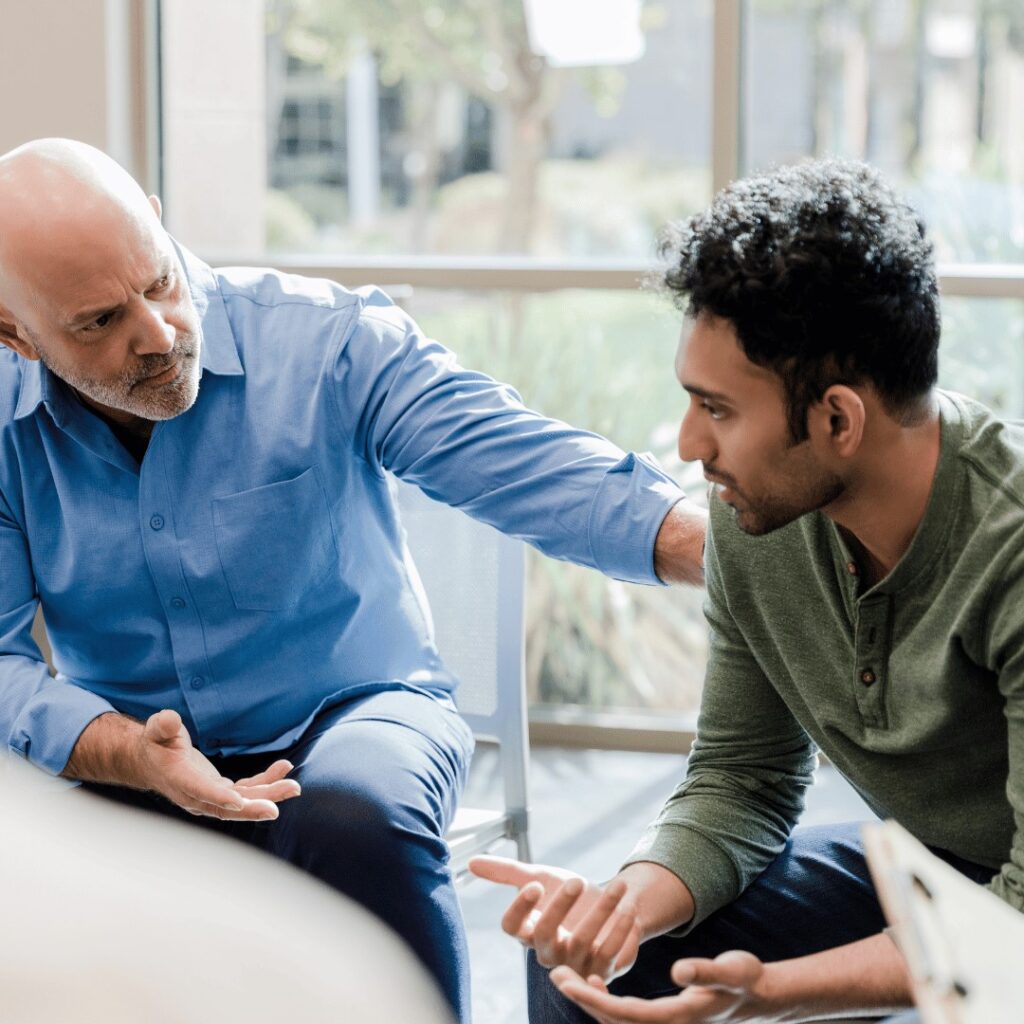In a world that prioritizes comfort and convenience, learning to sit with discomfort can be a revolutionary act. Discomfort comes in many forms: physical, emotional, psychological, and spiritual. It can arise from those minor irritations we all face, or from major life events that leave us reeling.
When experiencing discomfort, we want relief. Those major life events, in particular, often prompt a Google search for professional services. And that’s helpful. Yet most of us don’t know how to simply “sit with” discomfort, even when it’s on a smaller scale.
At Simi Valley Psychological Group, we understand that regardless of the source or intensity, how we respond to discomfort significantly impacts our well-being and personal growth. Simi Valley counseling can offer insights for how to navigate these challenging emotions.
Sitting with discomfort is not about passive endurance but about active engagement and understanding. Here we’ll explore the importance of sitting with discomfort (specifically emotional and psychological discomfort), the benefits of doing so, and practical strategies to develop this vital skill.
Understanding Discomfort

Discomfort is an inherent part of the human experience. It signals that something is not quite right, urging us to take action. When we’re dehydrated, for example, we may develop a headache. We could take an aspirin, which would alleviate the discomfort but mask the issue, or we could address the issue and drink some water.
Emotional and psychological discomfort are no different. The discomfort of things like strong emotions, general apprehension, overthinking, or the physical impact of ongoing stress can feel overwhelming, scary, or painful. In short, although common, it’s not fun to feel or experience these things.
Society often teaches us to avoid or numb discomfort through distractions, substances, or instant gratifications. While these quick fixes provide temporary relief, they prevent us from addressing the root causes of our discomfort and hinder our growth.
To sit with discomfort means to consciously and mindfully engage with our feelings and sensations, acknowledging them without judgment or immediate action to eliminate them.
This practice allows us to explore the underlying causes of our discomfort and gain insights into ourselves and our environment.
Sitting with Discomfort: Why It’s Hard
➔ Fear of Vulnerability
One common challenge in sitting with discomfort is the fear of vulnerability. Opening ourselves up to uncomfortable feelings can be daunting, especially if we are used to hiding or denying them. However, vulnerability is essential for genuine connection and growth. Embracing it can lead to profound personal transformation. At Simi Psychological Group, our compassionate therapists in Simi Valley help you work through this fear gradually.
➔ Misconception of Passivity
Sitting with discomfort is often misunderstood as passive suffering. In reality, it is an active and dynamic process that requires courage and intention. It involves engaging with our discomfort mindfully and compassionately, rather than merely enduring it.
One thing I share with my clients is the first step is harder than the second, third, and fourth. As you’re learning how to lean into discomfort, focus on just taking that first step forward.

➔ Instant Gratification Culture
Our society’s emphasis on instant gratification can make it difficult to sit with discomfort. We are conditioned to seek quick fixes and immediate relief.
Sure, scrolling social media for hours may distract you from something unpleasant, but as soon as you put the phone down, that unpleasantness is right there waiting for you.
Developing the patience and perseverance to face discomfort requires a shift in mindset and a commitment to long-term well-being over short-term comfort.
Sitting with Discomfort: Why it Matters
➔ Sitting with Discomfort Helps with Personal Growth
Discomfort often indicates an area where we need to grow or change. By facing it, we can identify limiting beliefs, unaddressed emotions, or unresolved conflicts that hold us back. This process can be transformative, leading to greater self-awareness and resilience.
➔ Sitting with Discomfort Helps Build Emotional Regulation Skills
Learning to sit with discomfort helps us develop emotional regulation skills. Instead of reacting impulsively to unpleasant feelings, we learn to pause, observe, and choose our responses more mindfully. This ability is crucial for maintaining healthy relationships and making thoughtful decisions.

➔ Sitting with Discomfort Increases Resilience
Regularly facing discomfort builds mental and emotional resilience. It prepares us to handle future challenges with greater ease and confidence.
Resilience is not about being unaffected by adversity but about bouncing back and growing stronger from it.
In the meantime, if you need more solutions when feeling overwhelmed, look at our blog, How Can I Calm Down my Anxiety in the Moment?
➔ Sitting with Discomfort Enhances Empathy
When we acknowledge and explore our discomfort, we become more attuned to the struggles of others. This empathy fosters deeper connections and more compassionate interactions, enriching our personal and professional relationships.
Sitting with Discomfort: How to Do It
Many useful tools are available to assist with mental health. Here are some practical strategies you can follow to get better at sitting with discomfort.
1. Mindfulness Meditation:
Mindfulness meditation is a powerful tool for developing the ability to sit with discomfort. It involves focusing on the present moment and observing thoughts and sensations without judgment. By practicing mindfulness, you train your mind to stay present with uncomfortable feelings instead of avoiding or suppressing them.
2. Breathing Exercises:
Conscious breathing can help you stay grounded during moments of discomfort. Techniques such as deep belly breathing, box breathing, or alternate nostril breathing activate the parasympathetic nervous system, promoting relaxation and reducing stress. These exercises create a sense of calm that allows you to face discomfort more effectively.
3. Body Awareness:
Paying attention to physical sensations in the body can provide valuable insights into your discomfort. Practices such as body scans, yoga, or progressive muscle relaxation help you connect with your bodily experiences. By noticing where and how discomfort manifests in your body, you can address it more holistically.
4. Journaling:
Writing about your discomfort can be a cathartic and enlightening practice. Journaling allows you to articulate your thoughts and feelings, providing clarity and perspective. It can also help you track patterns and triggers, leading to a deeper understanding of your discomfort and how to manage it.
5. Self-Compassion:
Treating yourself with kindness and understanding is crucial when sitting in discomfort. Self-compassion involves recognizing your shared humanity and acknowledging that discomfort is a universal experience. By being gentle with yourself, you create a supportive internal environment that encourages exploration and growth.
Take a look at our blog Self-Care Sunday Tips for more ideas on building self-compassion through self-care.
6. Seeking Support:

Sometimes, sitting with discomfort requires the support of others. Talking to a trusted friend, family member, or therapist can provide validation and guidance.
Support groups or mindfulness communities can also offer a sense of belonging and shared understanding, making it easier to navigate discomfort.
If you’re ready to look for professional support, we provide SImi Valley counseling to meet the needs of you and your family.
Not sure what to talk about in therapy? Check out our blog What to Talk About in Therapy: Establishing a Trusting Client-Counselor Relationship.
Sitting with discomfort is a powerful practice that fosters personal growth, emotional regulation, resilience, and empathy. It challenges us to face our fears, embrace vulnerability, and engage with our feelings and sensations mindfully. By developing strategies such as mindfulness meditation, breathing exercises, body awareness, journaling, self-compassion, and seeking support, you can learn to navigate discomfort with greater ease and insight. Ultimately, sitting with discomfort is not about eliminating it but about transforming our relationship with it. It is an invitation to explore the depths of your human experience, to grow through challenges, and to live more fully and authentically.
Simi Psychological Group in Simi Valley and Moorpark offers mental health services to meet the needs of the whole family, including therapeutic groups! In addition, our experienced and compassionate therapists treat children, adolescents, and adults, and offer treatment for anxiety, trauma, and couples counseling as well.
Contact us today for more information or a free consultation at (805) 842-1994.

Dr. Novak is the group practice owner and licensed psychologist at Simi Psychological Group a therapy practice in Simi Valley, California. Simi Psychological Group offers a variety of services including trauma therapy, couples therapy, anxiety therapy, teen therapy, and more. Simi Psychological Group emphasizes the importance of creating real change by making sure to get to the root of your struggles.




